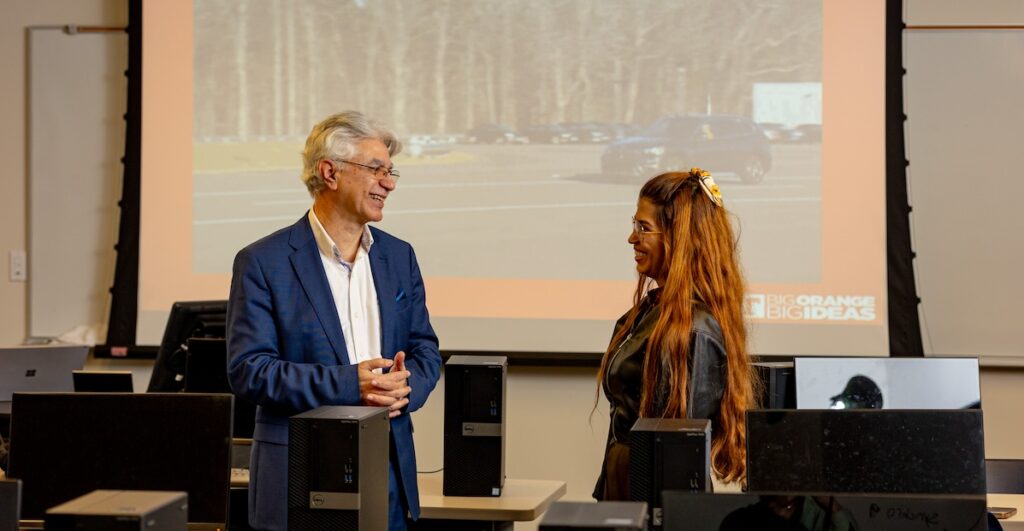Khattak and Moradloo Evaluate Nighttime Performance of Pedestrian Automatic Emergency Braking Systems
In 2022, an estimated 7,500 pedestrians were killed in traffic crashes in the United States—the greatest number of pedestrian traffic deaths the country has seen since 1981. The year before, pedestrians had accounted for one-sixth of traffic fatalities.
Most fatal traffic crashes in the US are caused by excessive speed or intoxicated driving, factors which impair a driver’s ability to respond quickly to new information like spotting a pedestrian.
“Pedestrian automatic emergency braking (P-AEB) systems engage automatic braking when the car senses a pedestrian and the driver fails to react,” said Beaman Distinguished Professor Asad Khattak. “This technology, which is associated with a 25% to 27% reduction in pedestrian crash risk during the day, has a substantial potential to mitigate pedestrian-involved crashes, injuries, and deaths under challenging conditions.”
Unfortunately, even though nearly 75% of fatal pedestrian crashes occur at night, P-AEB efficacy in low light has been limited by technological limitations. In fact, the Insurance Institute for Highway Safety (IIHS), a nonprofit vehicle crash research group, was only able to start gathering nighttime P-AEB data in 2021.
Improving Roadway Safety
Khattak, who coordinates the Transportation Group in UT’s Department of Civil and Environmental Engineering (CEE), is dedicated to improving the safety of America’s roadways—especially for vulnerable road users like pedestrians.
“UT offers a conducive environment for this type of research, largely thanks to our Center for Transportation Research (CTR),” Khattak said. “The collaboration between CEE and the CTR provides access to interdisciplinary research and funding opportunities, cutting-edge facilities, and technology-savvy students to help us address pedestrian safety.”
One of Khattak’s PhD students, Nastaran Moradloo, was drawn to UT by those transportation safety resources—and by Khattak’s safety research in particular.
“Dr. Khattak’s mentorship was the most important factor in my decision,” she said. “I knew his mentorship and the other expert faculty members in CEE promised an unparalleled learning and research experience.”
Analyzing Pedestrian Automatic Emergency Braking Systems
Last year, with funding from two US Department of Transportation research centers, Moradloo set out to determine the effectiveness of P-AEB systems at night. She analyzed nearly 2,000 field tests from the IIHS nighttime safety dataset, investigating correlations between P-AEB performance and factors like vehicle size, headlight technology, and P-AEB sensor type (cameras with or without radar sensors).
In addition to Khattak, Moradloo collaborated with UT alum and pedestrian safety researcher Iman Mahdinia (PhD ’21). Currently a postdoctoral researcher at the Safe Transportation Research and Education Center at the University of California, Berkeley, Mahdinia helped Moradloo design the study and prepare the results for publication.
Moradloo discovered that P-AEB systems substantially mitigated the risk of dummy ‘pedestrian’ collisions, safely stopping vehicles without a crash in about 64% of the nighttime tests. If a crash did occur, the P-AEB systems cut the speed of impact by 33% to 50%—reducing the chance of pedestrian fatality by more than 30% in some cases.
Moradloo also found several vehicle features that contribute substantially to P-AEB effectiveness: small vehicles, cars equipped with both cameras and radar sensors, and cars outfitted with LED headlights were much likelier to successfully avoid ‘pedestrian’ collisions.
“Recent sensor technologies and artificial intelligence advancements have already made exploring and improving P-AEBs in low-light conditions more feasible and effective,” Khattak said. “Nastaran’s study could change how P-AEB systems are improved in the future—in terms of their algorithms and the other car technologies that support them.”
This January, Moradloo presented the team’s research at the National Academies’ Transportation Research Board Annual Meeting. The feedback from meeting attendees was overwhelmingly positive.
“The safe mobility of pedestrians is integral to creating healthier, more equitable, and sustainable communities,” Khattak said. “Evolving technologies such as P-AEB can significantly enhance pedestrian safety if their limitations and shortcomings are well investigated and addressed.”
Contact
Izzie Gall (865-974-7203, egall4@utk.edu)
